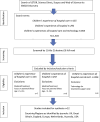Changing bodies: A scoping review and thematic analysis of family experience during serious childhood illness
- PMID: 37028372
- PMCID: PMC11607840
- DOI: 10.1177/13674935231168683
Changing bodies: A scoping review and thematic analysis of family experience during serious childhood illness
Abstract
This scoping review has investigated experiences of children and parents encountering in-patient treatment for serious childhood illness, including current or potential use of technology as a support mechanism. The research questions were 1. What do children experience during illness and treatment? 2. What do parents experience when their child is seriously ill in hospital? 3. What tech and non-tech interventions support children's experience of in-patient care? The research team identified n = 22 relevant studies for review through JSTOR, Web of Science, SCOPUS and Science Direct. A thematic analysis of reviewed studies identified three key themes reflecting our research questions: Children in hospital, Parents and their children, and Information and technology. Our findings reflect that information giving, kindness and play are central in hospital experiences. Parent and child needs in hospital are interwoven and under researched. Children reveal themselves as active producers of pseudo-safe spaces who continue to prioritise normal child and adolescent experiences during in-patient care.
Keywords: Parents; childhood illness; family; nursing.
Conflict of interest statement
Declaration of conflicting interestsThe author(s) declared no potential conflicts of interest with respect to the research, authorship, and/or publication of this article.
Figures
Similar articles
-
Children's and parents' experiences of home care provided by hospital staff: A scoping review.J Clin Nurs. 2024 Aug;33(8):3018-3032. doi: 10.1111/jocn.17109. Epub 2024 Mar 13. J Clin Nurs. 2024. PMID: 38481092
-
The impact of single and shared rooms on family-centred care in children's hospitals.J Clin Nurs. 2017 Jun;26(11-12):1584-1596. doi: 10.1111/jocn.13485. Epub 2017 Mar 24. J Clin Nurs. 2017. PMID: 27487434
-
Lived experiences: Growing up with a seriously mentally ill parent.J Nurs Scholarsh. 2024 May;56(3):357-370. doi: 10.1111/jnu.12955. Epub 2024 Jan 2. J Nurs Scholarsh. 2024. PMID: 38168092
-
[Experiences and support needs of parents of hospitalized children with multiple disabilities: a qualitative study].Pflege. 2016;29(2):73-82. doi: 10.1024/1012-5302/a000475. Pflege. 2016. PMID: 26974279 German.
-
Parents' early healthcare transition experiences with preterm and acutely ill infants: a scoping review.Child Care Health Dev. 2017 Nov;43(6):783-796. doi: 10.1111/cch.12458. Epub 2017 Mar 30. Child Care Health Dev. 2017. PMID: 28370174
References
-
- Boydell KM, Hodgins M, Pignatiello A, et al. (2014) Using technology to deliver mental health services to children and youth: a scoping review. J Can Acad Child Adolesc Psychiatry 23(2): 87–99. https://www.ncbi.nlm.nih.gov/pmc/articles/PMC4032077/. - PMC - PubMed
-
- Braun V, Clarke V. (2006) Using thematic analysis in psychology. Qualitative Research in Psychology 3(2): 77–101. DOI: 10.1191/1478088706qp063oa. - DOI
-
- Bruins Slot J, Hendriks M, Batenburg R. (2018) Feeling happy and carefree: a qualitative study on the experiences of parents, medical clowns and healthcare professionals with medical clowns. International Journal of Qualitative Studies on Health and Well-Being 13(1): 1503909–1503910. DOI: 10.1080/17482631.2018.1503909. - DOI - PMC - PubMed
Publication types
MeSH terms
LinkOut - more resources
Full Text Sources


